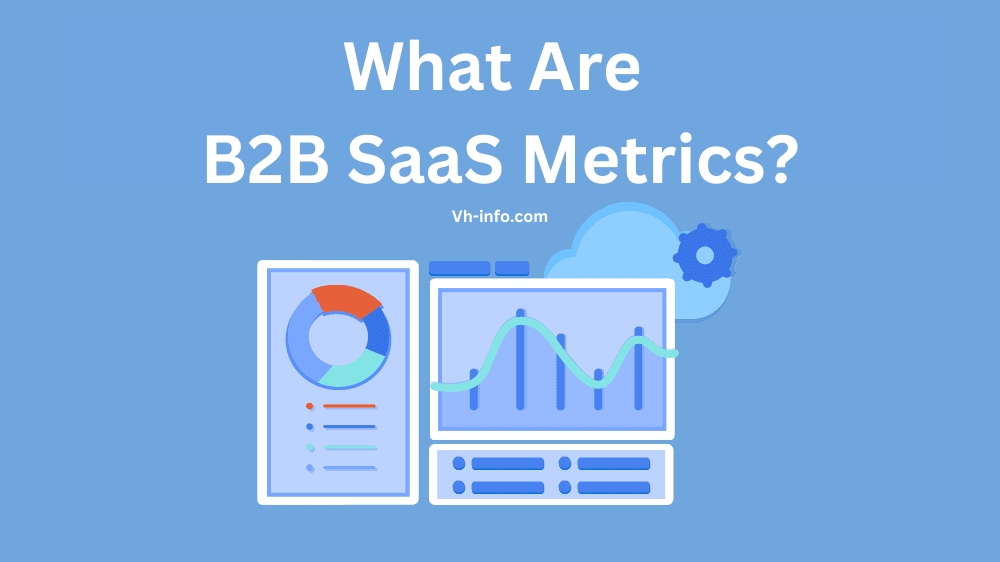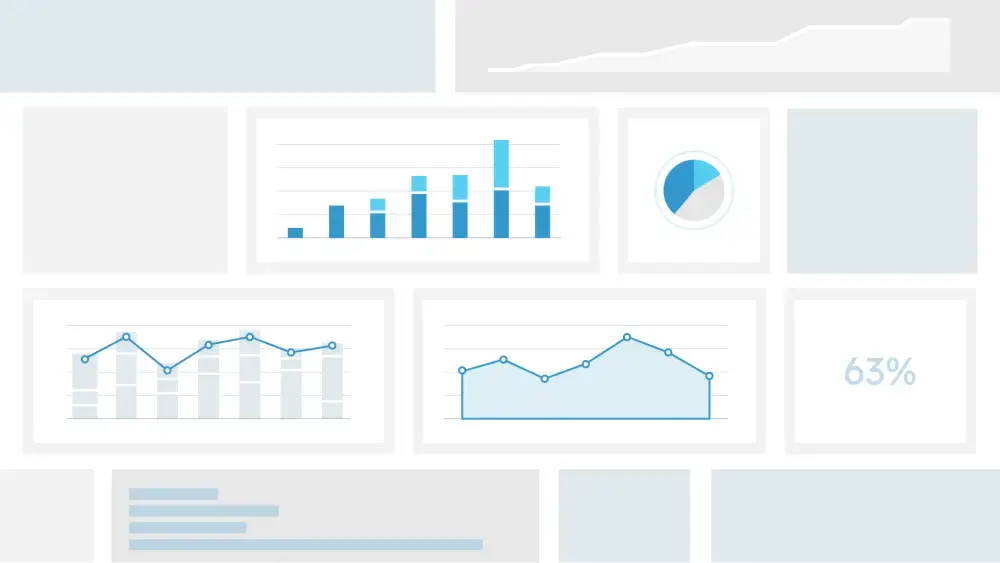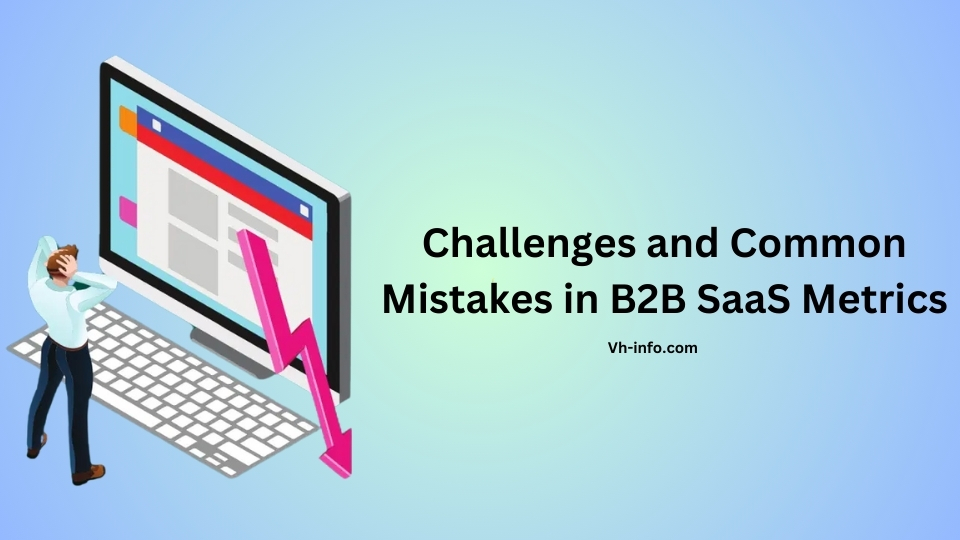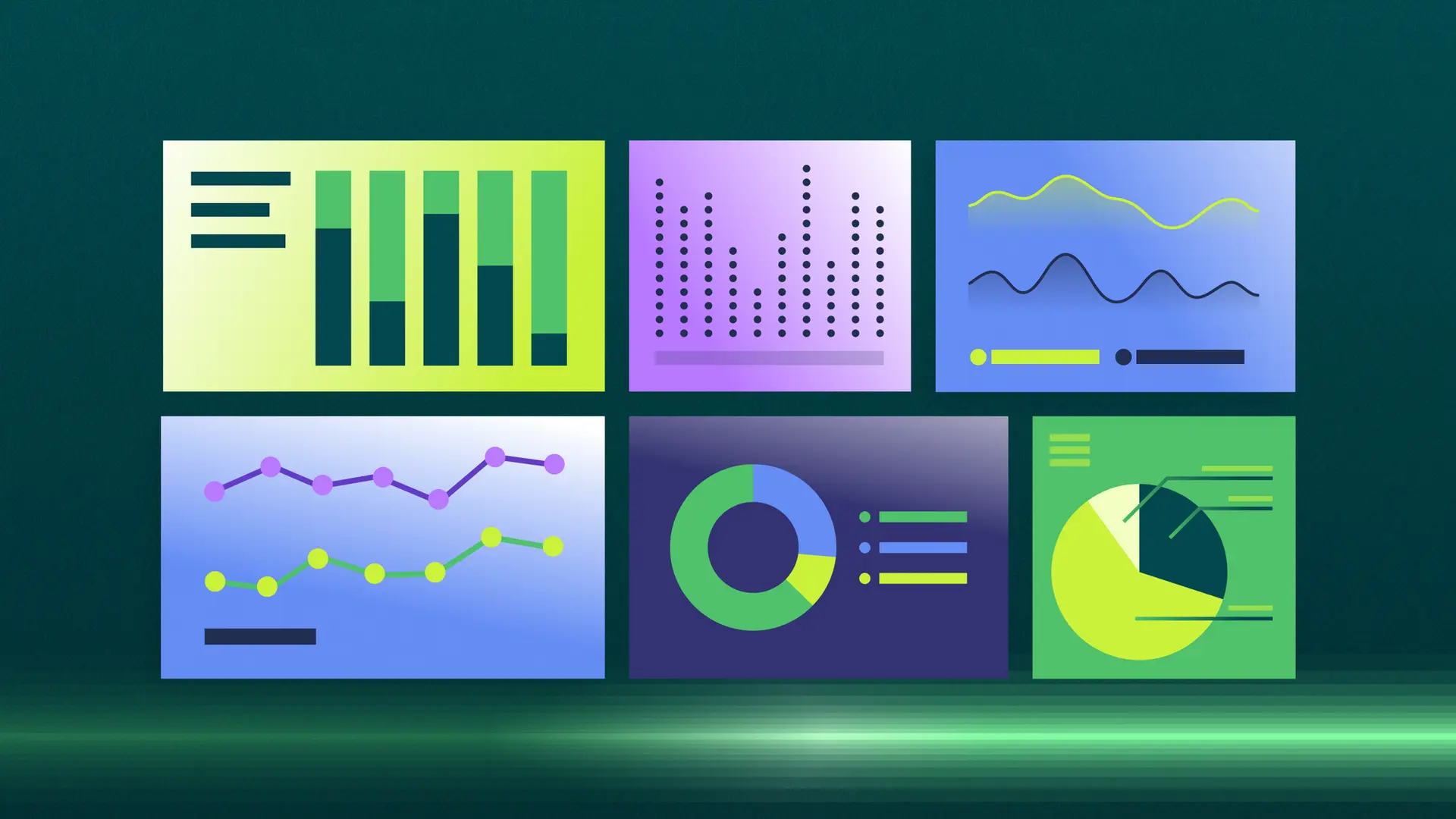B2B SaaS companies must maintain stable recurring revenue, keep customers satisfied, and maintain strong growth. Because competition is tight, measuring the right metrics is key to making better decisions.
At VH Info, we share straightforward steps for B2B SaaS marketing and link-building, focusing on metrics like monthly recurring revenue, churn rate, and net promoter score. These indicators direct your marketing plans, refine your sales process, and enhance product adoption.
Tracking them properly uncovers how to improve budgets, address user needs, and boost long-term performance. In this guide, we show you how to manage these metrics so your company makes smarter moves in a changing market.
What Are B2B SaaS Metrics?

B2B SaaS metrics are key performance indicators that help SaaS companies measure their business health, growth, and customer satisfaction. These metrics focus on recurring revenue, customer churn, total number of users, and operational efficiency.
Metrics like monthly recurring revenue (MRR) and annual recurring revenue (ARR) track predictable income, while churn rate and net promoter score (NPS) highlight customer retention and satisfaction.
Analyzing these numbers can help businesses improve their cash flow, optimize marketing efforts, and align strategies for sustainable growth over a given time period.
Key B2B SaaS Metrics to Track

Financial Metrics
Financial metrics confirm whether your recurring revenue model can sustain growth. They focus on revenue churn, total revenue, acquisition cost, and lifetime value, among other indicators.
Monthly Recurring Revenue (MRR)
Monthly recurring revenue is the average revenue generated by your total number of customers on a monthly basis.
This metric filters out one-time charges and focuses only on predictable subscription income. MRR serves as a pillar for B2B SaaS companies because it immediately shows the monthly revenue potential. A consistent uptick in this metric indicates a healthy, expanding customer base.
When the marketing team runs campaigns, MRR is used to interpret if those efforts help bring in more recurring revenue. The sales funnel also depends on MRR to determine how many new customers you need in a given month to sustain growth.
Annual Recurring Revenue (ARR)
Annual recurring revenue is the total revenue a SaaS company can predict it will earn each year from subscriptions.
ARR shows how much money you can expect over a larger period of time, factoring in any expansions or contractions that may happen among your customer base. This measure is often favored by investors looking for stable returns.
The ARR is simply your MRR multiplied by 12, adjusted for upgrades, downgrades, and churn. It helps you plan your budget, forecast cash flow, and set marketing expenses more accurately.
ARR also indicates whether you have enough momentum to lower your overall customer acquisition cost because an expanding ARR typically correlates with improved brand recognition.
Customer Lifetime Value (LTV)
Customer lifetime value (often abbreviated as CLV or LTV) measures the total amount of money an average customer will contribute to your SaaS business over their entire subscription. It blends monthly recurring revenue, average revenue per user, and churn rate to gauge how profitable each relationship can be across a given period.
When LTV is high, it’s often easier to justify higher spending on customer acquisition cost.
In other words, if your average customer contributes significant recurring revenue, you can afford more aggressive marketing efforts. A strong LTV also indicates that your customer success and customer support initiatives are effectively boosting retention and driving expansions or upsells.
Customer Acquisition Cost (CAC)
Customer acquisition cost weighs how much money you spend to draw in a new customer through marketing channels, social media, paid ads, lead generation campaigns, or sales outreach.
It’s the total cost over a time period divided by the number of new customers acquired in that window.
CAC ratio becomes essential for measuring whether your marketing team and sales team spend is justified.
If your CAC is too high relative to your customer lifetime value, you’re bleeding cash flow too quickly. On the other hand, a lower acquisition cost signals effective targeting, a refined sales process, and well-executed marketing efforts.
Gross Margin
Customer acquisition cost weighs how much money you spend to draw in a new customer through marketing channels, social media, paid ads, lead generation campaigns, or sales outreach.
It’s the total cost over a time period divided by the number of new customers acquired in that window.
CAC ratio becomes essential for measuring whether your marketing team and sales team spend is justified. If your CAC is too high relative to your customer lifetime value, you’re bleeding cash flow too quickly.
On the other hand, a lower acquisition cost signals effective targeting, a refined sales process, and well-executed marketing efforts.
Customer Retention Metrics
Customer retention metrics indicate how well you’re holding onto your customer base. These metrics shape your long-term strategies and can predict future churn or expansions.
Churn Rate
Churn rate is the percentage of customers who leave your SaaS product in a given month (or any defined time period).
A high churn rate usually underscores issues with your product’s user experience, the effectiveness of customer support, or possibly misaligned marketing messaging.
Lowering customer churn helps you retain a stable foundation of monthly recurring revenue.
This is vital because acquisition cost for a new customer can be steep. When you reduce churn rate, you free up resources to direct toward new feature development or marketing expansions instead of constantly replacing lost customers.
Net Revenue Retention (NRR)
Net revenue retention (NRR) tracks how the total revenue from your existing customers changes as they upgrade, downgrade, or churn over a period. If your NRR is above 100%, it means the expansions and upsells outweigh any lost revenue, indicating healthy business growth.
Companies with a high NRR thrive because their existing client base is generating revenue growth without needing consistent influx of new customers. This is especially beneficial when you factor in the total number of users who not only stay but also purchase more products or move to higher-tier subscriptions.
Customer Retention Rate (CRR)
Customer retention rate (CRR) measures the percentage of customers you keep over a given period, excluding new customer acquisitions. CRR focuses on the existing customer base, making it an essential counterpart to churn rate.
A solid CRR often mirrors robust product adoption, strong customer success programs, and an active user community. SaaS marketing strategies that address pain points and provide continued value often see an uptick in retention.
Engagement Metrics
Engagement metrics reveal how frequently and effectively customers are using your SaaS product after purchase, which informs your user experience improvements.
Net Promoter Score (NPS)
Net promoter score measures how likely your customers are to recommend your SaaS product to others. It’s calculated by subtracting the percentage of detractors from the percentage of promoters. An NPS score is a quick reference point for overall customer satisfaction.
If your NPS score is high, it generally signals strong word-of-mouth marketing, which helps reduce the personal acquisition cost for new leads. If your score declines, you might have a product issue or insufficient customer support that needs immediate remediation.
Daily Active Users (DAU) / Monthly Active Users (MAU)
Daily active users (DAU) and monthly active users (MAU) track the total number of users accessing your product daily or monthly. These metrics are especially useful for products that rely on continuous usage, such as SaaS platforms with day-to-day workflow features.
When you see dips in active users, it could point to poor adoption or a lack of user experience enhancements. On the flip side, steady active users indicate a thriving product that can attract more qualified leads.
Adoption Rate
Adoption rate measures the speed at which new or existing customers adopt specific features of your SaaS product. For instance, if you introduced automation functionality, the adoption rate would indicate how many users include it into their workflow.
A strong adoption rate suggests you’ve successfully communicated the value of new features, while a sluggish adoption rate might require additional marketing efforts or in-app guides.
Feature Usage
Feature usage tracks how often customers use particular functions within your SaaS product. It highlights which aspects of the product deliver the most value and which features need refinement.
If a certain feature sees consistently low usage, doubling down on user education or adjusting the feature for clarity could boost the average customer’s satisfaction. The right moves at the feature level can also enhance retention and reduce the churn rate.
Growth Metrics
Growth metrics prove whether your SaaS business model has enough traction. By monitoring expansions, you can optimize how the sales team and marketing team deploy resources.
Customer Monthly Growth Rate (CMGR)
Customer monthly growth rate measures the percentage increase (or decrease) in your total number of customers from one month to the next. This metric can help you project upcoming revenue growth and highlight potential dips in acquisition patterns.
If your CMGR is trending upward, your product is attracting a healthy inflow of new customers. A downward trend might point to inefficiencies in your sales process or the need for new “hooks” in the marketing funnel.
Expansion Revenue
Expansion revenue represents the additional recurring revenue you earn from existing customers.
This can happen through upselling to a higher plan or cross-selling complementary products. A steady stream of expansion revenue hints at customer satisfaction and an enthusiastic user base open to deeper product engagement.
As expansion revenue grows, your CAC ratio becomes more favorable because the customers you acquired some time ago continue adding net value without incurring more acquisition cost.
Operational Metrics
Operational metrics cover the internal mechanics that keep your SaaS business running smoothly. They include burn rates, time to value, and other measures that reflect overall business health.
Burn Rate
Burn rate measures how much money your SaaS company spends beyond what it generates in a given month. Tracking this helps plan how many months of runway remain before you need to raise funds or cut costs.
If your burn rate is too high, you may need to re-evaluate your marketing expenses or focus on retaining existing customers to maintain a positive cash flow. Sometimes, it might require shifting budget away from less impactful marketing efforts to more profitable channels.
Time to Value (TTV)
Time to value (TTV) is how long it takes for a new customer to see meaningful benefits from your SaaS product. A shorter TTV often correlates with higher satisfaction, quicker adoption, and a reduced churn rate.
When TTV is minimal, your funnel metrics improve because new leads convert more quickly into loyal customers. Coupling a shorter TTV with in-app guidance and robust customer success programs typically results in better retention and more referrals.
Why is Tracking B2B SaaS Metrics Important?
![]()
Tracking B2B SaaS metrics is a direct method for gauging business health and guiding strategic decisions. Without insight into which funnel metrics or growth metrics need improvement, you risk flying blind.
Here are some of the biggest reasons metric tracking is indispensable:
- Better Budgeting: You can see if your total revenue justifies marketing expenses or if you’re spending too much money for too little return.
- Alignment Across Teams: Metrics tie your sales process, product development, and marketing efforts together around common goals.
- Investor Relations: Key SaaS metrics for investors (such as annual recurring revenue) can secure better funding terms if your numbers show promise.
- Customer Retention: Monitoring churn rate and net promoter score helps you refine the user experience and ensure long-term satisfaction.
- Growth Forecasting: Metrics like CMGR, NRR, and expansion revenue offer important data for strategic planning.
Consistent metric analysis also keeps the marketing team and sales team on the same page. Whether focusing on number of leads or looking at net promoter score trends, everyone works toward improving a complementary set of data points.
How to Track Your B2B SaaS Metrics?

- Define Clear Goals: Before you record any funnel metrics or measure monthly recurring revenue, define what your SaaS business aims to accomplish within a set time period. Are you looking to improve the number of new customers each month, drive business growth with expansions, or reduce your churn rate? Having these goals sharpens your focus.
- Choose Relevant Metrics: Not every business needs to track every single metric. A smaller SaaS company might prioritize monthly recurring revenue and churn rate, while a more mature brand might look beyond that to net revenue retention and the number of active users. Pick the metrics that align best with your current goals.
- Use Analytics Tools: Software solutions like Mixpanel and Chartmogul can aggregate data on average customer behavior, MRR, and churn. With these platforms, you track multiple data points in real-time. They highlight changes in monthly revenue or customer churn rate, helping you respond quickly to dips in performance.
- Set Up Accurate Tracking: If your data isn’t accurate, your efforts to reduce your acquisition cost or optimize your marketing budget won’t be reliable. Ensure you integrate data from each channel—social media, email campaigns, paid ads, referral traffic—so you have a complete overview of your lead generation pipeline.
- Monitor and Analyze Regularly: Mark a schedule to analyze your metrics consistently. Reviewing them once a quarter might be too infrequent if you’re in a fast-scaling phase. Weekly or monthly reviews are more typical for B2B SaaS marketing metrics.
- Share Insights With Stakeholders: The best approach to data involves transparency. Everyone should have access to the same performance snapshots, whether it’s your marketing team, sales team, or top management. Sharing these insights fosters quick alignment on issues like rising churn rates or lower NPS scores.
- Optimize Based On Data: Use the insights from these metrics to adjust your product, refine your sales funnel, or create different marketing tactics. If you see that the average revenue per user is flat, for instance, you may test a new subscription tier. Likewise, if your CAC ratio gets out of control, reevaluate your campaigns to identify channels that secure the highest conversion rate.
Challenges and Common Mistakes in B2B SaaS Metrics

Misinterpreting Metrics: Sometimes, the same data can be viewed from multiple angles. For instance, a slow or declining number of users might not be alarming if you’ve recently pivoted to a higher-value segment. Always frame your metrics within the context of your business model and strategic shifts.
- Focusing On Vanity Metrics: A large total number of users might look impressive, but if few of those users become paying subscribers or generate high monthly revenue, that figure means little for real business growth. Focus on metrics that connect directly to profitability, retention, or expansions.
- Ignoring Customer Feedback: Metrics such as net promoter score (NPS) only tell part of the story. The direct feedback behind those scores often highlights where to make immediate changes. Not listening to detractors may drive them to churn, hurting your total revenue in the long run.
- Not Aligning Metrics With Business Goals: If your main objective is to improve annual recurring revenue, but your marketing team measures success by the number of leads generated, you could see a mismatch that doesn’t translate to more sales or customer retention. Make sure your funnel metrics and financial metrics map to the same strategic vision.
- Over-Reliance On a Single Metric: B2B SaaS companies sometimes emphasize one metric, such as MRR, at the expense of other measures like churn rate or NPS score. This shortsighted view could hide serious weaknesses in customer success or user experience. It’s better to track a handful of carefully chosen indicators covering multiple facets of business health.
- Not Regularly Reviewing and Updating Metrics: Metrics that were vital during an early product stage might lose relevance later. As you grow and add different subscription tiers, new metrics like annual contract value become more relevant. Update your data-tracking priorities to reflect your product’s lifecycle.
How to Improve B2B SaaS Metrics?

To Improve B2B SaaS Metrics follow these:
Improve Customer Acquisition Cost (CAC) With Product Analytics
One tactic is to refine marketing expenses based on deeper insights from product analytics. Look at which features spark consistent active users or lead to certain upsells. Target your qualified lead segments more precisely to reduce acquisition cost.
By effectively reading your funnel metrics, you can bring in the right number of leads without paying too much money for each.
Use Secondary Onboarding to Retain Existing Customers
A second or ongoing onboarding process helps ensure current customers are fully equipped to use your SaaS product. This practice taps into user experience improvements and fosters higher lifetime value.
Existing users often get overlooked, which can cause them to churn. Secondary onboarding keeps them engaged and lifts the average revenue by introducing them to advanced features.
Use Modals to Prompt Users to Upgrade Their Accounts
Well-placed pop-up modals can highlight relevant subscriptions or higher-tier options. This approach encourages the new customer or existing subscriber to see additional benefits, potentially boosting your expansion revenue.
Ensure these prompts are contextually triggered to maintain a helpful tone.
Use Tooltips to Drive Users to the Activation Points
Modals aren’t the only in-app feature that can guide behavior.
Tooltips placed on essential features reveal how to extract deeper value from your platform. These prompts help new users adopt key functionality and enhance the net promoter score if they realize your SaaS product’s full benefit quickly.
Offer in-App Self-Service Support to Reduce Churn Rate
Self-service resources like knowledge bases, chatbots, or tutorial videos often prove invaluable for lowering your customer churn rate. When users can solve minor problems without lengthy support tickets, they’re more inclined to remain loyal over a longer time period.
Launch NPS Survey to Find Detractors and Act On
An NPS survey can identify users who feel dissatisfied or borderline about your product.
Reaching out to these detractors to learn more helps you fix pressing concerns and reduce your revenue churn rate. Small improvements may convert them into promoters, amplifying the positive word-of-mouth among your total number of customers.
Best Tools to Track B2B SaaS Metrics

Userpilot

Userpilot helps SaaS businesses create seamless in-app experiences. With triggers, tooltips, and analytics, you see how many active users explore each feature, which fosters strong retention and lowers churn. Its step-by-step guidance allows you to shape user flows around relevant adoption triggers, ultimately aiding your marketing team and product team in offering data-backed improvements.
Mixpanel

Mixpanel is a robust platform for analyzing product usage, tracking funnel metrics, and understanding how different user segments behave over a given period. Through event-based tracking, Mixpanel reveals which steps in the sales funnel or onboarding process lose the highest number of leads. This data helps your sales process and marketing efforts become more efficient.
Chartmogul

Chartmogul focuses on recurring revenue analytics. It helps you track monthly recurring revenue, annual recurring revenue, net revenue retention, and more. This tool makes it easier to measure changes in churn rate and average revenue per user. It also consolidates financial data from multiple payment gateways, giving you a full picture of your business growth.
FAQ’s:
What Is Needed To Be Successful in the B2B SaaS Marketing Space?
A refined sales funnel, strong lead generation strategies, alignment between marketing team and product team, and a thorough approach to collecting data on net promoter score, MRR, and other metrics.
By staying aware of your total number of customers and the monthly recurring revenue generated, you can distribute resources more accurately. Maintaining a healthy cash flow and consistent user experience is also vital.
What Are The Most Critical B2B SaaS Metrics For Startups?
Startups typically keep a close eye on churn rate, customer acquisition cost, monthly recurring revenue, and the total number of users.
Tracking growth metrics like CMGR and net revenue retention also supports strategic decisions early on. If you’re a new SaaS company, you need these metrics to confirm product-market fit and see if your marketing expenses produce a desired return.
Can Customer Feedback Play a Role in Metric Analysis?
Yes. Feedback often clarifies why metrics shift.
For example, an NPS survey might reveal friction in your user experience, causing the number of leads converting to drop. Feedback also guides improvements for average customer lifetime value if you address pain points that drive cancellations.
Listening to user comments can yield actionable fixes for your monthly revenue or net promoter score.
Conclusion
Monitoring B2B SaaS metrics is vital for sustaining recurring revenue, keeping a strong client base, and maintaining adequate cash flow.
Concentrating on monthly recurring revenue, annual recurring revenue, churn rate, and expansions gives you a concrete view of performance and where to refine strategies. This data-driven approach helps marketing, sales, and product teams collaborate around shared goals, ensuring proactive responses to shifts in customer behavior or market conditions.
Tracking metrics like CAC ratio, net promoter score, and retention indicators equips you to spot bottlenecks and make fast improvements to user experience and conversion funnels. Observing these numbers regularly highlights where budget can be redirected or where a new feature might boost average revenue per customer.
Each metric clarifies a different part of the journey, helping you stay one step ahead of churn and strengthen total revenue.
Through a methodical review process, you also gain better alignment across departments, reducing unnecessary costs and miscommunication. VH Info offers focused guidance on applying these insights, pushing your B2B SaaS platform toward long-term success.

